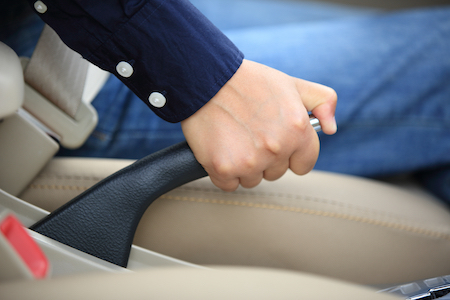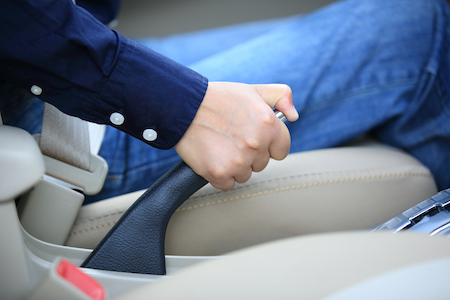Your car’s braking system is one of the most essential mechanisms built in for safety. Imagine driving down the mountain after a day of skiing without it. Even coming to a stop for a stoplight would be a harrowing experience if something were to go wrong.
While your front and rear brakes make up the most important part of the braking system, there’s a third brake that doesn’t get as much attention yet is equally important: the parking brake. The parking brake is connected to the rear brake system, and is used mainly as a failsafe if something were to happen to your brakes during your normal drive.
The parking brake is a secondary brake system that is designed to be independent of the front and rear brakes. This is your safety feature. You’ll find the control for your parking brake in one of four places:
- Center console – it’s a lever located between the two front seats
- Foot pedal – it’s a pedal located on the floor on the far left of all other pedals
- Stick – in older vehicles, you may find the emergency parking brake lever located on the instrument panel
- Push button – on newer vehicles, a push button exists on the console with other components
The mechanism is available for easy access.
If you drive a manual transmission, you may be used to using a parking brake to keep your car from rolling. But that doesn’t make a parking brake on an automatic transmission any less important. In truth, everyone should be familiar with the uses of a parking brake, and utilize it to make your driving experience safer.
How a parking brake works
 Your vehicle’s brakes are designed to bring your car to a stop. The more pressure you apply to the brake pedal, the more tension is transferred from the brake pad to the wheel, slowing your car until it eventually stops.
Your vehicle’s brakes are designed to bring your car to a stop. The more pressure you apply to the brake pedal, the more tension is transferred from the brake pad to the wheel, slowing your car until it eventually stops.
When you engage the parking brake, discs inside your rear wheel squeeze up against the inner part of the wheel in much the same way. This action slows the wheel, eventually stopping it and keeping it from rolling away.
While parking brakes work in a slightly different manner from vehicle to vehicle, to engage the parking brake, fully engage the rear brake system by pressing down on the brake pedal. Only then should you pull the lever or press the button for the parking brake system. Once the parking brake is in place, shift your car into park. Then release the brake pedal. This allows the hydraulic system to activate and do its work without putting added stress on the transmission.
Why your vehicle has a parking brake
In everyday situations, you might be tempted to only utilize your vehicle’s braking system. When you place your vehicle in park, a parking pawl is pushed into one of the grooves of the transmission gear to keep it from moving. A parking pawl is nothing more than a hammer-shaped pin that drops into place. While it might be enough force in everyday situations, it can weaken over time, especially if you’re on steep inclines or hills. One small pin stopping a several ton vehicle will only work for so long.
If you don’t use your parking brake regularly, this parking pawl weakens over time. That can impact your transmission system, or cause accidents as your vehicle rolls away. That can lead to expensive repairs.
Get in the practice of using your parking brake
Even if you infrequently drive, even if you park in relatively flat areas across the Front Range, your vehicle can still be at risk. If you’re putting your car in park, it’s a good idea to engage the parking brake too.
We advise using a parking brake no matter where you park your vehicle, but especially as your risk level increases.
Are you parallel parking on a hill? Engage your parking brake.
Are you filling up your vehicle at a gas station? Engage your parking brake.
Will you be leaving your car in a parking garage for hours at a time while you head into the office? Engage your parking brake.
It’s better to be safe than sorry. And a parking brake gives you added insurance to ensure your vehicle stays safe.
In many cases, people refer to a parking brake as an emergency brake. That title may be a bit misleading, making you think you only need it in emergency situations. The parking brake not only keeps your vehicle from moving, but it also saves your transmission from wear and tear. And that can save on repair bills down the road.
Using a parking brake in an emergency
Your car’s braking system is a complex mechanical system. Over time, it can fail, and that could be catastrophic depending on where it happens. That’s where the emergency brake comes into play. If you’ve ever referred to the parking brake as an emergency brake, this is why.
In the case of brake failure, you have seconds to react. A natural reaction is to stomp on the parking brake pedal, or pull up on the parking brake lever as hard as possible. Resist that urge. That will send your car into a tailspin, and possibly put you in even more danger.
Instead, slowly engage the emergency brake as your car comes to a stop. The parking brake is designed to hold your car in place, not stop it. As it engages, it slows your vehicle down until the point you can gain control.
Get a full brake inspection
If the concept of using your parking brake regularly is still new to you, put it into practice today. It can help your vehicle have a longer lifespan, as well as keep it safer over time.
Have a question about how well your brakes work? It’s time for a complete brake inspection. It’s the easiest way to determine how safe your entire braking system really is. By bringing it in, we can tell you how much wear is left on your brake pads, and give you tips on better driving and maintenance. If you pinpoint issues early, you’ll stay safer in the long run.
When was the last time you had a full brake inspection?

 On modern cars, however, the parking brake is rarely needed in that circumstance. That could be why the name has morphed over time from the emergency brake to the parking brake.
On modern cars, however, the parking brake is rarely needed in that circumstance. That could be why the name has morphed over time from the emergency brake to the parking brake.